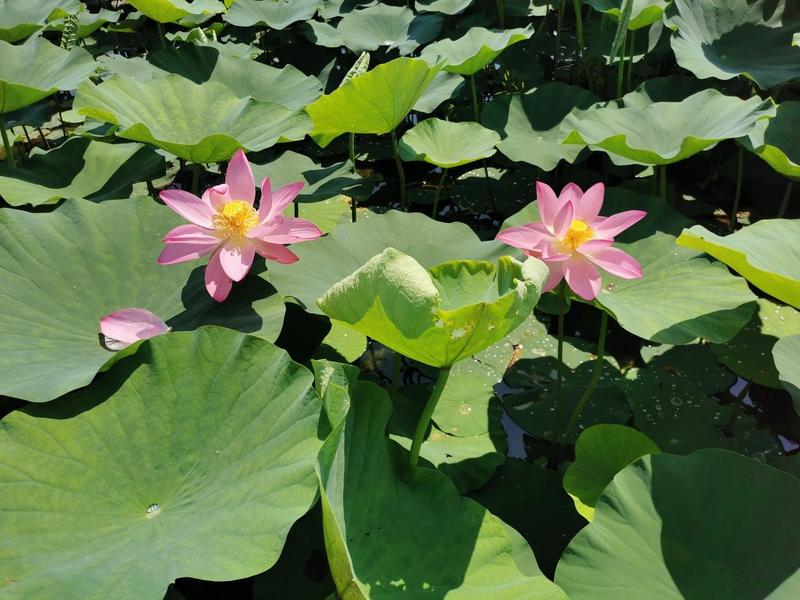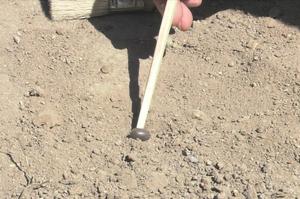 Lotuses blossom again from "antique" seeds, which were buried underground for over a century in the ruins of Yuanmingyuan in Beijing. (WANG KAIHAO / CHINA DAILY)
Lotuses blossom again from "antique" seeds, which were buried underground for over a century in the ruins of Yuanmingyuan in Beijing. (WANG KAIHAO / CHINA DAILY)
It is probably difficult for today's people to imagine how splendid the architecture by the shore looked, with its breathtaking backdrop of flourishing lotuses, before the havoc of 1860.
That was the year when invading Anglo-French forces burned down Yuanmingyuan, or the Old Summer Palace, in Beijing. Sprawling over 340 hectares, this former Qing Dynasty (1644-1911) resort used to be hailed as the "garden of gardens".
Thanks to 11 lotus seeds, unearthed by archaeologists in 2017 in the Ruyuan Park area of Yuanmingyuan, some of that splendor has returned-like envoys traveling through time to represent the strong spirit of the past, today.
With July here, the flowers are blooming again in Yuanmingyuan Ruins Park, thanks to technicians' devoted cultivation.
The 11 seeds, the first of their kind ever found in the Yuanmingyuan ruins, were moved to the laboratory at the Institute of Botany affiliated to the Chinese Academy of Sciences, where they were protected and nurtured. Six of the seeds later sprouted.
"They grow much slower than regular lotus," Zhang Huijin, a botanist at the institute, says. "And buds would soon have become rotten if they stayed in earth."
Consequently, it seems a better choice to let them "come home".
"They have slept for such a long time, and suffering from poor nutrition," Zhao Aimei, the leading horticulturist in charge of the program, says. "We were worried whether these fragile seeds could blossom or not."
Two of the sprouts were left in the lab as samples, and four returned to Yuanmingyuan last year.
 One of the 11 lotus seeds unearthed from Ruyuan Park area in Yuanmingyuan in 2017. (PHOTO PROVIDED TO CHINA DAILY)
One of the 11 lotus seeds unearthed from Ruyuan Park area in Yuanmingyuan in 2017. (PHOTO PROVIDED TO CHINA DAILY)
Even though Zhao says it feels like "nothing special" to grow these old seeds, she still gives particular attention to them. She cleaned their pond more often, compared with other young ones, and prayed for the best result.
Unfortunately, only two of them finally blossomed last year. However, for the rebirth of ancient lotus varieties, this is a genesis.
In April, Zhao's team began to expand the cultivation by separating their lotus roots. And their "sons" now cover about 80 square meters of water in the breeding base of Yuanmingyuan Ruins Park.
The specific variety of these "antique" lotuses remains unknown as they differ from other lotuses grown in the park, Zhao says, but follow-up genome sequencing will unveil the connection with their relatives.
About 300 varieties of lotus now grow in Yuanmingyuan Ruins Park. Over 60 hectares of the waters in Yuanmingyuan are now covered by them, making the site the biggest collection of the flowers in Beijing.
Zhao says the lotuses will reach their full blossom in mid-August, and for the two ponds of flowers that have grown from the sleeping beauties, they look stronger this year.
"Probably, they'll have seedpods this year," Zhao says. "If we can get more seeds, maybe we can begin considering our next step to move them from the breeding base into the wild."
Following archaeological discoveries at the Yuanmingyuan site over recent years, many original areas have been restored to partially reflect the palace's former glory.
"Yuanmingyuan witnessed a country's pain," Li Bo, director of the administration of Yuanmingyuan Ruins Park, said in a previous interview with China Daily. "However, its rejuvenation also marks the people's progress. To partially restore historical areas based on academic studies is a good way to recall patriotism."
Perhaps, the rebirth of the lost lotuses is a crucial way to achieve that.


